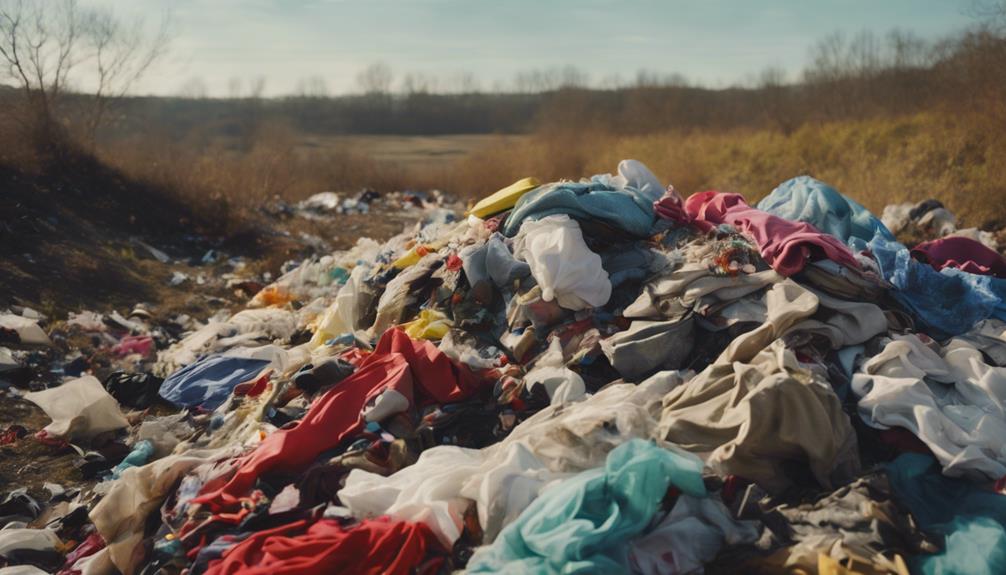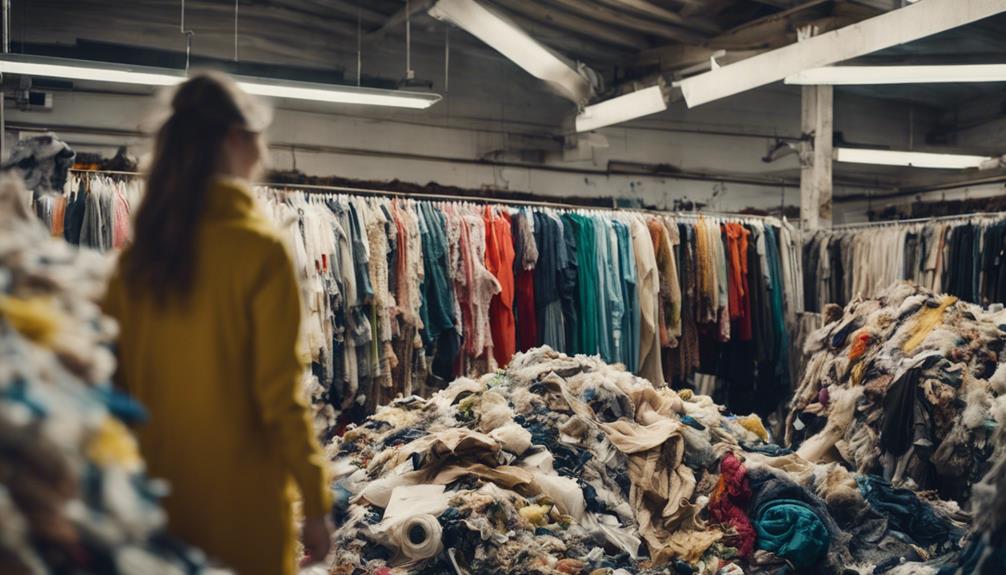Sustainable fashion benefits from important elements like ethical sourcing, durable materials, and innovative recycling practices. Prioritizing quality over quantity significantly reduces waste and pollution. Utilizing recyclable and biodegradable fabrics helps lessen the fashion industry’s significant environmental impact and the expected 148 million tons of waste by 2030. Consumers, particularly millennials, are increasingly requesting eco-friendly options, prompting brands to adjust. Additionally, smart shopping tactics such as thrift store purchases and clothing swaps further exemplify sustainable ideals. It is interesting how your decisions can influence change in this sector. Continue to explore to discover more insights and surprising practices in sustainable fashion!
Key Takeaways
- Prioritizing quality over quantity significantly reduces clothing waste, as 60% of garments are discarded within a year.
- Adoption of circular economy principles emphasizes recycling and upcycling, crucial for minimizing fashion waste projected to reach 148 million tons by 2030.
- Utilizing biodegradable materials and natural dyes can mitigate the environmental impact of clothing production, addressing severe water pollution issues.
- Consumer demand for sustainable options is rising, with 71% of millennials prioritizing eco-friendly brands, driving industry change.
Importance of Sustainable Fashion
Sustainable fashion is crucial because it tackles the fashion industry's massive environmental impact, making it essential for a healthier planet. As the second-largest polluter globally, the fashion industry is responsible for 20% of industrial water pollution. By prioritizing sustainable fashion, you contribute to reducing this alarming statistic. Furthermore, by embracing sustainable fashion trends, consumers can support ethical and transparent practices within the industry. This includes choosing clothing made from eco-friendly materials, supporting fair labor practices, and promoting the circular economy by participating in clothing swaps and recycling programs. By doing so, individuals can play a significant role in reducing the fashion industry’s negative impact on the environment and encouraging positive change towards a more sustainable future.
When you choose quality over quantity, you're not only making a smarter purchase but also helping to minimize the 60% of clothing that ends up in landfills or incinerators within just a year.
Ethical fashion aligns with sustainable practices, encouraging a more responsible approach to consumption. With 71% of millennials now prioritizing sustainability in their shopping choices, you can be a part of this growing movement. This shift in consumer awareness drives demand for eco-friendly alternatives, pushing brands to commit to sustainable practices.
Moreover, sustainable fashion promotes a circular economy through recycling and upcycling, which can help mitigate the projected rise of fashion waste to an astounding 148 million tons by 2030. By supporting sustainable and ethical fashion, you're taking a significant step toward protecting the planet for future generations.
Effects of Fashion Waste

Fashion waste has dire consequences for the environment, contributing considerably to pollution and resource depletion. You might be surprised to learn that the apparel and footwear industries account for 8% of global greenhouse gas emissions. This staggering figure highlights how your choices can impact climate change.
Additionally, about 60% of clothing items are tossed aside within a year, often ending up in landfills or incinerators, which only exacerbates fashion waste issues. The production of clothing also leads to severe water pollution, responsible for 20% of global industrial waste. This is particularly concerning when you consider that synthetic fabrics can take 30 to 40 years to decompose. As a result, the environmental footprint of fashion waste extends far beyond just discarded items.
Currently, the fashion industry generates around 92 million tons of waste annually, with projections suggesting this could rise to 148 million tons by 2030. By embracing slow fashion, you can help combat these alarming statistics. Choosing quality over quantity not only reduces waste but also promotes a more sustainable approach to fashion. Your choices matter, and they can lead to a healthier planet.
Innovations in Sustainable Practices

Innovative practices are reshaping the industry, making it easier for you to make environmentally friendly choices in your wardrobe. Sustainable brands are leading the charge with exciting innovations in textile production that focus on reducing waste and environmental impact.
| Innovation Type | Description |
|---|---|
| Recycled Materials | Patagonia uses recycled polyester fleece from plastic bottles, turning waste into fashion. |
| Biodegradable Fabrics | New textile innovations include biodegradable fabrics and natural dyes that lessen pollution. |
| 3D Knitting Technology | This technology allows for on-demand production, minimizing waste by crafting items directly from digital designs. |
Moreover, many companies are embracing circular fashion principles, designing clothes that can be recycled or upcycled. Subscription services and clothing rental models provide sustainable alternatives to fast fashion, allowing you to explore diverse styles without contributing to waste. As you explore your wardrobe options, these innovations help you make choices that align with your values and support a more sustainable future.
Smart Shopping Strategies

Embracing smart shopping strategies can amplify the impact of your sustainable choices, allowing you to curate a wardrobe that reflects your values while minimizing environmental harm. One of the best ways to do this is by prioritizing thrift stores and consignment shops. Not only do these options support sustainable fashion, but they also offer unique items that you won't find in mainstream retailers.
Before you shop, take time to research ethical brands. With 71% of millennials prioritizing sustainability, knowing which brands align with your values can guide your purchases. Avoiding fast fashion retailers is vital, as the average clothing item lasts about three years before being discarded, contributing to the alarming statistic that 60% of clothing ends up in landfills within a year.
Investing in timeless pieces instead of trendy items guarantees longevity, reducing waste. Extending the use of clothing by just nine months can decrease its environmental impact by 30%.
Community Engagement Solutions

You can boost community engagement in sustainable fashion by participating in clothing swap events, local fashion initiatives, and education programs.
These activities not only help reduce waste but also build connections among like-minded individuals.
Clothing Swap Events
Clothing swap events create vibrant community spaces where participants can exchange gently used items while promoting sustainable fashion practices.
By attending these swaps, you not only refresh your wardrobe without spending money but also engage in sustainable practices that help reduce waste. When you swap clothes, you divert textiles from landfills, making a positive impact on the environment.
These gatherings foster social interaction, turning what could be a mundane task into a fun community event. As you mingle with others who share your values, you raise awareness about fashion waste issues and inspire each other to adopt more mindful consumption habits.
Furthermore, clothing swaps build networks that support sustainable practices. You'll find that the connections formed at these events encourage you to reflect on your purchasing decisions beyond the swap. By participating, you become part of a movement that values sustainability and community engagement.
In essence, clothing swap events aren't just about exchanging clothes; they're about creating a culture of shared resources and fostering community ties that can lead to lasting change in how we approach fashion and consumption.
Local Fashion Initiatives
Local fashion initiatives create opportunities for individuals to engage with their communities while promoting sustainable practices and reducing clothing waste. By participating in community-based clothing swaps, you can exchange garments with neighbors, lowering overall consumption and fostering connections. These local initiatives not only allow you to refresh your wardrobe without spending money but also encourage everyone to reflect on the environmental impact of their clothing choices.
Events organized by local initiatives often raise awareness about fashion waste issues. When you attend these gatherings, you'll learn how sharing clothing within your community can greatly reduce reliance on fast fashion. Engaging in these activities strengthens community ties and encourages collaboration, as residents work together to devise sustainable solutions to clothing waste.
Moreover, local fashion events enhance your understanding of recycling and repurposing clothing. You'll gain valuable insights into how to make more conscious choices, ultimately contributing to a healthier planet. By supporting these initiatives, you not only promote sustainability but also create a vibrant, interconnected community focused on reducing waste and embracing responsible fashion practices.
Community Education Programs
Empowering community members through education programs can greatly enhance awareness and promote sustainable fashion practices. These community education programs focus on the environmental impact of clothing waste, revealing that the fashion industry accounts for 8% of global greenhouse gas emissions.
By organizing local events and clothing swaps, these initiatives foster community engagement, encouraging you to share resources and adopt sustainable practices within your network.
Research shows that 71% of millennials prioritize sustainability when shopping, underscoring how effective these programs can be in shaping consumer attitudes toward eco-friendly choices. Participating in workshops and informational sessions on clothing care and repair can markedly extend the lifespan of garments, reducing environmental impacts by up to 30% when clothing use is increased by just nine months.
Moreover, engaging in discussions about ethical fashion and recycling initiatives empowers you to make informed choices. Currently, less than 1% of clothing materials are recycled, costing the fashion industry $100 billion annually.
Future of Sustainable Fashion

The future of sustainable fashion promises exciting innovations in materials and production processes that prioritize eco-friendliness and minimize environmental impact. As consumer awareness grows, you'll find a rising demand for sustainable options. In fact, 71% of millennials prioritize sustainability in their shopping choices. The industry is set to adopt circular economy principles, focusing on recycling and waste reduction. Without action, fashion waste could reach a staggering 148 million tons by 2030.
To illustrate the key aspects of this shift, here's a quick overview:
| Key Factor | Description | Impact |
|---|---|---|
| Innovations in Materials | Use of biodegradable and recycled materials | Reduces resource depletion |
| Circular Economy Principles | Emphasis on recycling and reusing products | Minimizes waste and resource use |
| Consumer Collaboration | Brands engaging with consumers on sustainability | Strengthens community and brand loyalty |
| Regulatory Changes | New laws promoting sustainable practices | Sets industry standards |
These changes are essential for ensuring the long-term viability of your favorite fashion brands while also protecting our planet. Embracing sustainable fashion isn't just a trend, it's a necessary evolution.
Consumer Education and Awareness

You need to understand how to research sustainable brands to make informed fashion choices.
By educating yourself about the environmental impact of your purchases, you can support ethical practices and challenge misleading claims.
This knowledge empowers you to contribute to a more sustainable future in fashion.
Sustainable Brand Research
Researching sustainable brands helps consumers make informed choices and encourages a shift towards responsible fashion practices. When you delve into the details of a brand's sustainability credentials, you not only elevate your consumer awareness but also promote ethical practices in the fashion industry.
Here are a few key reasons to research sustainable brands:
- Understanding a brand's transparency helps you identify potential greenwashing and make ethical decisions.
- Engaging with brands on social media can clarify their sustainability values, fostering a connection to ethical fashion.
As you explore these options, keep in mind that increasing consumer education on sustainable practices is essential. It empowers you to navigate the often confusing landscape of fashion choices.
Informed Fashion Choices
Making informed fashion choices hinges on understanding the sustainability practices of brands, especially as 71% of millennials now prioritize eco-friendly options in their shopping habits.
Consumer education plays an essential role in this shift. By engaging with campaigns and resources—like podcasts and guides on ethical brands—you can learn about the environmental impact of your fashion decisions.
It's alarming that less than 1% of clothing materials are recycled, costing the fashion industry $100 billion annually. This underscores the importance of making informed choices to drive better recycling efforts. Researching sustainable brands before purchasing helps you avoid greenwashing and confirm your support goes to genuinely eco-friendly companies.
Moreover, engaging with brands about their sustainability credentials can foster transparency and trust. When you ask questions and seek clarity on practices, you empower yourself to make more informed fashion choices.
As a consumer, your awareness and actions can contribute to a more sustainable industry. So, explore the world of sustainable fashion, and let your shopping habits reflect your values! Remember, your informed choices today can lead to a greener tomorrow. Support brands that prioritize ethical practices, such as fair wages and environmentally friendly production processes. Take time to research and spot sustainable fashion tips that can help you identify eco-friendly materials, like organic cotton or recycled fabrics. By making these mindful decisions, you play an essential role in fostering positive change within the fashion industry.
Frequently Asked Questions
What Are the Factors Affecting Sustainable Fashion?
When you consider sustainable fashion, think about materials, production processes, waste management, and consumer behavior. Your choices impact the environment, so embracing quality over quantity and supporting ethical brands can drive meaningful change in the industry.
What Are the Key Sustainability Challenges in the Fashion Industry?
Steering through the fashion industry's sustainability challenges feels like walking through a minefield. You've got consumer reluctance to pay more, confusing “green” labels, and limited eco-friendly choices, all complicating your quest for responsible fashion.
Why Are People Interested in Sustainable Fashion?
You're interested in sustainable fashion because it aligns with your values, reduces environmental impact, and promotes responsible consumption. By choosing eco-friendly brands, you contribute to a healthier planet and support ethical practices in the fashion industry.
What Are Some Interesting Facts About Sustainability in Fashion?
Sustainability in fashion is like a double-edged sword; it reveals shocking stats. Did you know fast fashion leads to 60% of clothes in landfills? By extending clothing lifecycles, you can considerably reduce environmental impact.
Conclusion
In the ever-evolving landscape of fashion, embracing sustainability is your modern-day quest for a Grail.
By making mindful choices, supporting innovative practices, and engaging with your community, you not only reduce waste but also inspire others on this journey.
As you don the garments of tomorrow, remember that every small step contributes to a larger movement.
Together, let's weave a future where style meets responsibility, turning fashion into a force for good.









